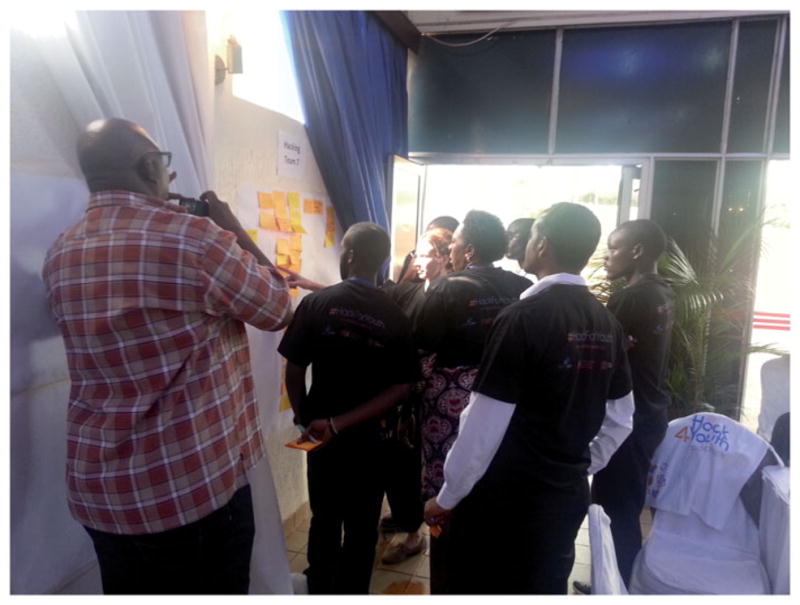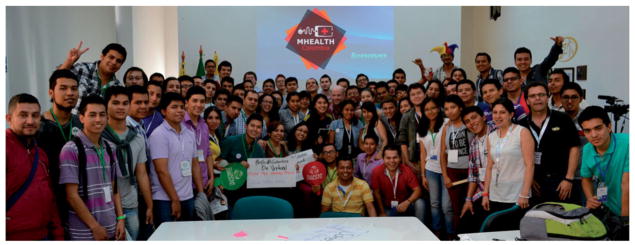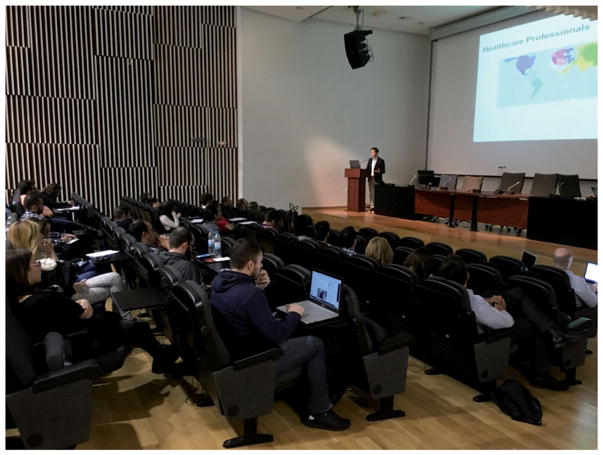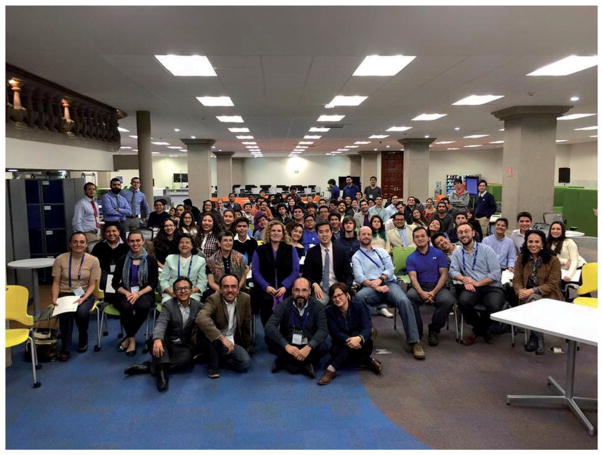Abstract
The challenge of providing quality healthcare to underserved populations in low- and middle-income countries (LMICs) has attracted increasing attention from information and communication technology (ICT) professionals interested in providing societal impact through their work. Sana is an organisation hosted at the Institute for Medical Engineering and Science at the Massachusetts Institute of Technology that was established out of this interest. Over the past several years, Sana has developed a model of organising mobile health bootcamp and hackathon events in LMICs with the goal of encouraging increased collaboration between ICT and medical professionals and leveraging the growing prevalence of cellphones to provide health solutions in resource limited settings. Most recently, these events have been based in Colombia, Uganda, Greece and Mexico. The lessons learned from these events can provide a framework for others working to create sustainable health solutions in the developing world.
Keywords: mHealth, hackathon, Sana, global health, health informatics
1. Introduction
Engineers have become increasingly drawn to problems in healthcare.[1] The challenge of providing quality care to underserved populations in remote rural settings has, in particular, attracted a lot of interest among engineers seeking to provide societal impact through their work. Sana is an organisation hosted at the Institute for Medical Engineering and Science at the Massachusetts Institute of Technology (MIT) that was established out of this interest. The group consisted initially of engineers, doctors, entrepreneurs and public health practitioners from Harvard and MIT brought together by a passion to improve health outcomes using technology, but rapidly expanded as it attracted colleagues especially from low- and middle-income countries (LMICs).
Information and communication technology (ICT) has generated considerable enthusiasm with its potential to expand the reach of a limited supply of specialist expertise. Mobile health, or mHealth, exploded as cellphones became not only ubiquitous but also more powerful. An estimated USD 4.3B was invested in digital health technologies in 2015 alone, supporting the creation of >160,000 iOS and Android health-related apps.[2]
The hope that problems in global health with social costs will be solved by technology alone is unrealistic, however, so much so that failures and disappointments in the promise of technology are inevitable. High-tech innovations addressing low-hanging fruits abound but very few attempt to tackle systems-level factors contributing to poor health. Clinical aspects of the disease may be addressed but not its social determinants. To date, no mHealth app has been adopted across populations and led to sustained improvement in health outcomes.[3] An mHealth app, or any innovation for that matter, is fated to fail unless it is incorporated into a comprehensive, systemic solution that attempts to address the multitude of issues at hand with respect to a particular disease.
This paper describes Sana’s ideas incubator initiative through hackathon events around mobile health, or mHealth, in resource-constrained settings. Although Sana is not alone in its use of hackathons to spur innovation around mHealth, [4–6] the group and its global partners believe there is value in sharing their experiences and lessons learned through this report.
A hackathon brings people from various backgrounds together for problem-solving. They are typically organised as intense, short-duration competitions where teams generate innovative solutions. The hackathon model integrates collaboration, idea generation and group learning by bringing together different stakeholders in a mutually supportive setting. In 2015, Sana organised mHealth engineering bootcamps and hackathons across the globe with a diverse mix of partners. The Sana mHealth engineering bootcamp is an intensive 2- to 4-day programme to accelerate proficiency in global health informatics, to leverage international engineering resources and build mHealth capacity. The programme is designed to introduce computer science, informatics and engineering students to mobile health, providing them with the technical concepts as well as the clinical perspectives to effectively design and implement mobile health solutions. Immediately following the intensive bootcamp, the students are teamed up with local clinicians or other experts in the field to share ideas and innovate in an organised hackathon, bringing theory into practice. The 2- to 3-day event allows the participants to immediately apply the concepts and lessons on actual projects, working in multidisciplinary teams to develop rapid prototypes and solve real problems. These projects may then be continued as research or start-up ventures, while other students can benefit by continuing with more extensive health informatics training. We write this report with our colleagues from Colombia, Uganda, Greece and Mexico and share lessons learned from the mHealth events.
2. Hackathons
2.1. Colombia hackathon
Popayán, Department of Cauca, Colombia was the site of mHealthColombia, [7] a week long mHealth boot-camp and hackathon in June 2015, led by Sana, local academia, and the ICT industry, with the objective of developing mobile solutions to healthcare problems specific to the Colombian ecosystem. The event was motivated by interest from the Colombian government in innovating processes in healthcare and ICT.
The lack of digital records in the Colombian healthcare system was identified as a significant challenge during preparations for the mHealthColombia event and therefore chosen as one of the primary areas of focus. Existing mobile applications and frameworks such as Sana Mobile were proposed as tools that could be incorporated into solutions. Presentations by international experts and descriptions of existing tools were provided during the 3-day bootcamp, held prior to the hackathon, to help improve the understanding of issues relevant to mHealth, as well as the technical skills of the hackathon attendees. Four primary health topics were addressed during the workshops as suggested by local stakeholders: telemedicine, caregiver support, standards and interoperability and quantified self. In order to generate a creative atmosphere to identify relevant health problems, the event took place inside a complex of medical clinics. Participants interacted with patients and ICT professionals to spawn ideas and iterate their prototypes with help from end users.
Colombia hackathon
More than 70 participants were grouped into 18 interdisciplinary teams who received advice from mentors from MIT, Massachusetts General Hospital –Harvard Medical School, Universidad del Cauca, Universidad EIA, Universidad CES, Tecnologico de Monterrey (Mexico), Microsoft Colombia, Fraunhofer Institute Germany, Pan American Health Organization and Cluster CreaTIC. Mentors assisted the participants with product development, market analysis, programme monitoring and evaluation based on their expertise in mHealth in different countries and contexts. Projects revolved around wearable technologies and personal health records as well as improving communication between patients and their caregivers.
The majority of the participants were students with significant software development skills resulting in prototypes having a reasonably advanced level of development. Limited participation of healthcare providers, however, presented a considerable shortcoming. While a significant number of clinicians were invited to participate, very few showed up for the event. It is not clear if this were due to lack of interest, insufficient health ICT training in medical school, or limited availability. Most likely, there was little incentive for healthcare providers to attend. Those who work in public hospitals or clinics have to find coverage for their clinical responsibilities while those who work in the private sector lose potential income to attend a 2-day event. Finding ways to address these conflicting needs and to include more physicians in the unavoidable digitalisation of healthcare represents an ongoing challenge to the country.
Overall, mHealthColombia was still hugely successful because it created new opportunities for collaboration, as well as entrepreneurship provided by the start-up accelerator CreaTIC. The event assembled a community of developers, and fostered networking with local industry and international partners.[8]
2.2. Uganda hackathon
The United Nations Population Fund (UNFPA), in partnership with Sana, organised a global “Hack For Youth” in Kampala, Uganda in July 2015. The hackathon challenged 80 participants from 17 countries to design and develop creative technology solutions to adolescent sexual and reproductive health (ASRH) issues. UNFPA convened a diverse group of participants, including young people and youth developers, as well as stakeholders from academia, UN agencies, and public and private sector that were experienced or operational in ASRH initiatives. Drawing on UNFPA’s core focus and experience supporting programming for young people, active youth participation throughout the hackathon helped to bring the user perspective to the forefront, guiding the design of the platforms conceptualised during the hackathon.

Uganda hackathon
The hackathon’s specific thematic focus in addressing ASRH challenges guided the structure of the event. Globally adolescents and youth face significant healthcare concerns, including risk of adolescent pregnancy, child marriage, HIV and AIDS, intimate partner violence and limited access to contraception.[9] This is evident in Uganda where teenage pregnancy rates are 24%, [10] over 140,000 unsafe abortions occur annually among young women aged 15–24 years, [11] and young people account for a significant percentage of new HIV infections.[12] In this context, we believed that a hackathon could provide an opportunity to find innovative new means to address specific challenges that young people experience in safeguarding their sexual and reproductive health, such as barriers to receiving health information or accessing youth-friendly services.
Given the diverse set of stakeholders participating in the hackathon, including programmatic and technical experts, as well as young people, UNFPA was intentional in developing a toolkit (or “Playbook”) to guide participants throughout the event. Rather than the usual primarily self-directed hackathon programme, the Playbook provided a step-by-step programme through the Sana innovation design process. The toolkit fostered radical collaboration and human-centered design principles to encourage liberal brainstorming and unconventional, innovative solutions. This was implemented because most of the participants were inexperienced with hackathon events and many came from rigidly structured operational environments, where the design process was unfamiliar. The Playbook can easily be adapted to other hackathon contexts, and draws on design thinking principles. The hackathon teams were preassigned to ensure a diverse multidisciplinary composition, taking into account the geographical priorities and contexts that would guide each team’s solutions, as well as language requirements. In advance of the hackathon, an online survey was developed to draw input from youth globally, to identify the ASRH problems they encounter, ensuring a greater number of youth voices were part of the hackathon.
From the start of the hackathon, the participants were encouraged to identify the key ASRH challenges they wished to address, without focussing on specific technology solutions to encourage divergent creative ideas. Over the next 2 days, guided by the Playbook and supplemented by topical workshops on operating ASRH programmes and mobile health design theory, the teams iterated their designs and built mobile app prototypes. Each of the teams received guidance and feedback from Sana and UNFPA, providing mentorship in mobile health and ASRH. The hackathon concluded with a public pitch session where an expert panel of judges and the public voted to select the winning prototypes.
The success of the UN in convening such a diverse group of stakeholders involved significant challenges. It proved difficult to find the right balance between orienting the technical participants to the specific ASRH content, while also ensuring participants were aware of the potential technologies that they could utilise in their solutions. This also impacted the overall timing of the event, including balancing the necessary orientation, design and development periods, alongside demos of mHealth platforms created by youth developers in Uganda, press conferences, and team-building activities. Furthermore, the global nature of the hackathon meant that after the hackathon, follow-up efforts would be more challenging.
Recognizing these challenges, we determined that an active follow-up plan would be necessary to ensure the greatest impact from the hackathon. In the follow-up to the hackathon, three of the winning teams are developing their detailed proof of concept and implementation plans for platforms related to sexual harassment reporting, gamification of ASRH information, and support to community health workers to reach young mothers, with support from UNFPA and mentors from Sana.
2.3. Greece hackathon
The Aristotle University of Thessaloniki, in collaboration with the Department of Informatics and Telecommunications of the University of Western Macedonia, organised a Sana mHealth Bootcamp Workshop and an mHealth Hackathon in October 2015 in Thessaloniki, Greece.[13] Health scientists, innovators and engineers guided students in the identification of significant local healthcare problems and development of solutions based on open source mHealth technology. Participation by students in the event presented an important opportunity given the current low rank Greece has in mHealth market readiness among the European Union countries based in part on developer competences.[14]
Following the Sana approach promoting multidisciplinary participation, the event included graduate and undergraduate students from engineering, health informatics and medicine as well as healthcare experts, developers, innovators and entrepreneurs active in the Greek mHealth business sector. In particular, health professionals working in the national health system as well as in research participated thanks to the endorsement of the event from the 4th Regional Health Authority of Central Macedonia and the Faculty of Medicine of the Universities of Thessaloniki and Thessaly. Attendance consisted of 110 students (out of 180 that applied) for the mHealth bootcamp with 45 participating in the hackathon.
The objectives and agenda of the bootcamp discussions were around global health challenges relevant to Greece and the application of mHealth technology to address these challenges. Participants attended talks from local experts to increase their understanding of the complexity of healthcare issues, including obstacles to providing high quality care. Lectures and hands-on exercises provided participants with an introduction to mHealth software development tools, platforms, and the utilisation of existing open source software. Topics included design thinking, clinical decision-making, Android programming, medical data standards and ontologies, clinical data analytics, Electronic Health Records (EHRs), medical devices and sensors and regulatory issues. Case studies of Greek mHealth applications through real-life demonstrations and interactive panel discussions were presented.
Greece hackathon
The hackathon provided an opportunity for clinicians, entrepreneurs, scientists and engineers to work together as they identified local health needs and developed open source mHealth solutions. The hackathon started with participants pitching problems, followed by the formulation of multidisciplinary teams. The bulk of the hackathon was spent on prototype development using the material and tools presented during the bootcamp. Ten teams developed Android mHealth applications from smoking cessation to communication aids for the deaf and mute. Smoking represents a significant health problem in Greece with some of the highest rates in the world.[15] The hackathon concluded with project presentations and an awarding ceremony.
2.4. Mexico hackathon
In early January 2016, Sana and the Tecnológico de Monterrey in Mexico City hosted a similar bootcamp and hackathon event focused on the needs of the growing geriatric population.[16] This event was developed with the support of MIT International Science and Technology Initiatives (MISTI), Graduate School of Education, Humanities and Social Sciences of Tecnologico de Monterrey, the Medix Laboratories Co., CinepolisKlic Co. and Microsoft Research Azure Co. The local community of physicians and researchers chose to focus the efforts of this hackathon on the geriatric population given the significant challenges facing elder care over the next years. In Mexico, the fastest growing segment of the population is those over 65, with a predicted census of 15.3 million by the year 2030.[17] Compounding this challenge of a growing elderly population is the number of geriatricians available. To date, Mexico has approximately 500 formally trained geriatricians. The event therefore focussed on mobile health solutions to address the growing needs of the elderly population.
Mexico hackathon
Attendance reached 75 participants broken into 11 multidisciplinary teams composed of telecommunication and computing engineers, biotechnologists, high school students, social workers and geriatricians. The week began with 2 days of presentations covering both the clinical needs of the geriatric population as well as technical tutorial in and design strategies for mHealth software development. The bootcamp set the stage for a 3-day hackathon where 11 groups developed novel and diverse mobile health solutions, from assisting patients with urinary incontinence exercise to connecting caretakers and patients through a social network app.
This hackathon was successful primarily because of the attendance of geriatricians during the weeklong event thanks to the commitment of the director of a local geriatrics programme. Clinical input from idea generation throughout the design process was crucial in identification of relevant problem areas and development of solutions that address not just the clinical condition but the social determinants as well.
This hackathon was unique with the inclusion of high school students. Despite their relative lack of experience, the students were extremely enthusiastic and were able to make significant contributions to their teams. Those without technical experience assisted with presentations and marketing plans. Initial concerns that the high school students might feel intimidated working with graduate and undergraduate students were dispelled. By the end of the event, the high school students were pleased with their contributions, and expressed strong interest to participate in similar events in the future.
3. Lessons learned
One of the most fundamental challenges faced by the hackathon community is how to define and measure success. Is success measured by the number of mHealth app prototypes at the end of the event? Is it the number of start-up companies that are spawned? Or the participants’ experience and learning from the event?
The success of an event must include an assessment of the event as experienced by the participants. Since the events typically occur over the course of several days, assessment of the participant experience should occur throughout the event as well as in the form of a thorough review once the event has concluded. The most critical source of that information comes from the direct feedback provided by the participants themselves. The primary approach employed for obtaining this feedback has been to engage participants in informal discussions either individually or in larger groups. In that context, a number of themes emerged that reflect the hackathon experience. Some are more easily measured such as whether the environment provided a network with adequate connectivity, a sufficient number of power outlets were present, seating was available for all the participants, an adequate number of restrooms were available, to name a few. Additional subjective measures include the general level of noise or other distractions, level of lighting, room temperature and availability of refreshments. In general, a successful event should provide participants with an environment that is comfortable and conducive for creativity.
Product commercialisation has not been the focus of the Sana hackathons for several reasons. A recent study from Harvard Business School found that 95% of start-ups between 2000 and 2010 failed to see the projected return on investment. Start-ups in the healthcare arena tend to address low-hanging fruits; any potential benefit is trumped by much bigger issues in the rest of the healthcare value chain. Better clinical outcomes, the objective of every healthcare start-up if it were to succeed, almost always requires a multi-pronged, inter-disciplinary, collaborative approach, which often runs counter to the entrepreneurial spirit. Hackers need to understand better the systems-level issues in healthcare delivery if they are to create sustainable and scalable solutions. They also need to know what have been tried, what have failed and why they failed so as not to “reinvent the flat tire”. More important than mobile health applications, what is needed in systems-level innovations. While incredible advances have been made to health “gadgets” like low-cost point-of-care diagnostics, or wireless monitors, what remains to be developed are innovations that will integrate these components into health systems in a manner that can be brought to scale. The global health community need innovations in the delivery infrastructure that is supported by an information system that distributes and integrates care delivery most efficiently. This is the key message that Sana tries to impart to the hackathon participants through presentations from local healthcare experts and interactions with local mentors.
Beyond the impact hackathons have through the solutions they generate, they provide authentic learning experiences that promote content mastery, development of technical and thinking skills, and creation of supportive professional and social networks. They have been championed as a powerful new pedagogy, able to provide students opportunities to learn and solve problems in authentic contexts, using twenty-first century skills and technologies, and to break down walls between classrooms, peers, role models and mentors. However, little formal research has been done on the types and mechanisms of learning during hackathons, or how these are impacted by the design and execution of these events. To that end, Sana is organising a summer 2016 workshop called “Hacking Hackathons” that will bring together Sana hackathon alumni from around the globe to share their experiences and lessons learned, and work with education experts to maximise the learning from these events. The goal of “Hacking Hackathons” is to partner with education organisations such as the MIT Teaching Systems Lab that have experience in evaluating education programmes for quality improvement in order to define and refine our approach to capacity building.
At the end of the day, the Sana mHealth boot-camps and hackathons are not about the apps built, but more about the relationship fostered between the engineers, the healthcare providers and other participants. It is about the software developers acquiring the deeper level of understanding required to solve complex, systemic health problems. It is about the healthcare providers becoming empowered to improve the way they deliver care and appreciating opportunities to contribute to innovation. Achieving these goals is challenging to measure, and for that reason, improving these bootcamps and hackathons is difficult.
4. Final remarks
Technology alone will not improve health outcomes. This is a crucial message that we emphasise in every hackathon. ICT, as in every technological innovation in healthcare, has a number of prerequisites for success. The main objective of the hackathons is therefore to bring together engineers with their technical skillset, clinicians who are most knowledgeable about the problems in healthcare and other experts including patients and end-users. We believe that understanding all the layers of complexity is the crucial first step to leverage advances in ICT in order to improve healthcare delivery, and that this is only possible through a multidisciplinary approach.
Footnotes
Disclosure statement
The authors report no conflicts of interest. The authors alone are responsible for the content and writing of this article.
References
- 1.Celi LA, Ippolito A, Montgomery RA, et al. Crowdsourcing knowledge discovery and innovations in medicine. J Med Internet Res. 2014;16:e216. doi: 10.2196/jmir.3761. [DOI] [PMC free article] [PubMed] [Google Scholar]
- 2.Healthcare Finance [Internet] 2015 [cited 2016 Feb 23]. Available from http://www.healthcarefinancenews.com/news/digital-health-scored-43-billion-2015-funding-rock-health-says.
- 3.Powell AC, Landman AB, Bates DW. In search of a few good apps. JAMA. 2014;311:1851–1852. doi: 10.1001/jama.2014.2564. [DOI] [PubMed] [Google Scholar]
- 4.Mobile Health Hackathon Belgium [Internet] Brussels, Belgium: [cited 2016 May 21]. Available from: http://mhealth.be/en/storify/ [Google Scholar]
- 5.Hackathon: Mobile Apps for Global Good in Healthcare –Analytics [Internet] Virginia, USA: [cited 2016 May 21]. Available from: https://www.icat.vt.edu/content/hacka-thon-mobile-apps-global-good-healthcare-analytics. [Google Scholar]
- 6.SXSW’s Official Hacking Competition: The AT&T and Health 2.0 Mobile App Hackathon [Internet] Texas, USA: [cited 2016 May 21]. Available from: http://www.health2con.com/devchallenge/sxsws-offical-hacking-competition-the-att-and-health-2-0-mobile-app-hackathon/ [Google Scholar]
- 7.mHealthColombia [Internet] Popoyan, Colombia: [cited 2016 Feb 23]. Available from: http://www.mhealth.com.co/ [Google Scholar]
- 8.Rojas-Potosi L, Pedraza-Alarcon E, Chamorro-Vela D, et al. #mHealthColombia entrenamiento y hackathon en soluciones móviles para el sector salud como dina-mizador del ecosistema de innovación TIC en el Departamento del Cauca. Proceedings of VII Iberoamerican Congress of Telematics; 2015. pp. 284–290. [Google Scholar]
- 9.UNFPA Annual Report 2013 [Internet] Available from: http://www.unfpa.org/publications/state-world-population-2013.
- 10.Uganda Demographic Health Survey. [Internet] Kampala, Uganda: Uganda Bureau of Statistics; Aug, 2011. Available from: http://www.ubos.org/onlinefiles/uploads/ubos/UDHS/UDHS2011.pdf. [Google Scholar]
- 11.Sing S, Prada E, Mirembe F, et al. The incidence of induced abortion in Uganda. Int Fam Plan Perspect. 2005;31:183–191. doi: 10.1363/3118305. [DOI] [PubMed] [Google Scholar]
- 12.AIDS Indicator Survey Uganda 2011 [Internet] Kampala, Uganda: Ministry of Health; Aug, 2012. Available from: http://health.go.ug/docs/UAIS_2011_REPORT.pdf. [Google Scholar]
- 13.Sana Θεσσαλíνíκη Bootcamp-Hackathon [Internet] Thessaloniki, Greece: [cited 2016 Feb 23]. Available from: http://thomikara.wix.com/hachathon-bootcamp. [Google Scholar]
- 14.research2guidance EU Countries’ mHealth App Market Ranking 2015 [Internet] Berlin, Germany: May, 2015. Available from: http://www.digitalezorg.nl/digitale/uploads/2015/07/research2guidance-EU-Country-mHealth-App-Market-Ranking-2015.pdf. [Google Scholar]
- 15.The Greek Tobacco Epidemic [Internet] Cambridge, MA: Harvard School of Public Health; Dec, 2011. Available from: http://www.who.int/fctc/reporting/party_reports/greece_annex1_the_greek_tobacco_epi-demic_2011.pdf. [Google Scholar]
- 16.Proyecto SANA-ITESM [Internet] Mexico City, Mexico: Tecnologico de Monterrey; 2016. Jan, [cited 2016 Feb 23]. Available from: http://sitios.itesm.mx/eehcs/sanaitesm/ [Google Scholar]
- 17.Perfil sociodemográfico de adultos mayores. [Internet] Mexico City, Mexico: Instituto Nacional de Estadística y Geografía; 2014. Available from: http://internet.contenidos.inegi.org.mx/contenidos/productos//prod_serv/contenidos/espanol/bvinegi/productos/censos/poblacion/2010/perfil_socio/adultos/702825056643.pdf. [Google Scholar]





